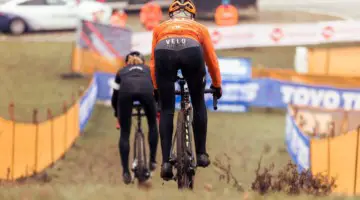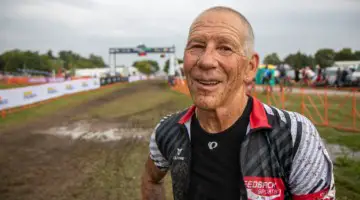Cross is coming to the Bluegrass State. This December, the (second) 2018 U.S. Cyclocross National Championships will be held in Louisville, Kentucky. I’m from Kentucky and went to school in Louisville, so I’m pretty stoked Louisville gets to hold yet another national championship.
Later in the year, I’d like to write a more specific column about what to see, where to stay and perhaps what bourbons to keep your eyes out for. For now, I’d like to focus on the course and offer some advice for those athletes looking to tailor their training for success at the first December Nationals since 2010.

The Elite Women hit the holeshot at the 2017 Pan-American Championships. © D. Perker / Cyclocross Magazine
The Basics
First, how to pronounce it! If you’re going to insist I say Hoogerheide correctly, I’m going to ask you at least try to say Louisville correctly. There are really five pronunciations, as evidenced here. They are more or less listed in order; most local to least local. Give it a shot, you’ve got months to work on it.
The course is at Joe Creason Park. Except for the Derby City Cup weekend in 2017, this venue has not been used before, nor will it be during 2018 prior to Nationals. Don’t show up at Eva Bandman Park (the 2013 World Championship venue) down by the river looking for Nationals. The new venue is a few miles south of Eva Bandman, across from the Zoo and Mega Caverns.
The Venue and Course
The terrain is much like Devou Park, the former Pan American Championships and current Cincinnati Cyclocross weekend venue, in that it’s very open with a lot of climbing. Stephen Hyde said it was one of the most difficult courses in America in terms of effort, and I agree. The 2017 Derby City Cup layout was one of the most pedal-heavy, power-intensive courses I have done, and it included a ~ 90-second climb back up to pit two. At least one of the downhills was so technical, it didn’t really allow for any recovery either.
The start at the 2017 Derby City Cup was flat and headed around a mass of tennis courts before coming back to the team tent area. The finish was somewhat isolated from where spectators congregated, and word on the street is it is likely to move for the 2018 Nationals. The course featured several technical sections, including one right before the finishing straight.
From a training perspective, riders are likely going to want to train for the technical climbs and descents in the second half of the course after the flyover. Joe Creason Park features what can best be described as a giant bowl, and course designers are likely to make good use of its slopes and spectator-friendly nature.

The Derby City Cup lap finished with a muddy, technical section. 2017 Derby City Cup. © D. Perker / Cyclocross Magazine
The weather that time of year will be somewhat unpredictable. Largely I’d say to expect temperatures in the 30s, but it could be more or less depending on the day. There will be mud or actually, clay. It’s particularly sticky and thick there, and I don’t expect it to drain all that well, unlike Devou which is higher up and has better wind exposure. In short, I think we’re in for a cold-ish hard slog with a decent amount of running depending on where you are in the field. The technical sections are more or less single file.

This 2017 race at the Derby City Cup featured a good amount of mud. 2017 Derby City Cup. © D. Perker / Cyclocross Magazine
Preparing for Nats Glory
How would I suggest preparing for it? First, get used to low cadence, sustained power application. There was almost no sprint/brake on the course as set up for the 2017 Derby City Cup, and there’s a lot of climbing. The muddier it is, the worse the climbing is going to be.

The climbs were greasy and long all weekend. 2017 Pan-American Championships. © D. Perker / Cyclocross Magazine
The good news is it’s easy to work on low cadence power on a trainer, which is where a lot of people will be in preparation for Nationals. Within that prep, I’d suggest some core work too. Pushing big gears slowly means you need something to brace against during the effort. A weak core will mean a blown back from those efforts. Also, I’ve found a solid core really helps to control the bike in the technical sections. I was riding one technical section based on core stability more than anything else.
I would also add some running to your training. There’s at least one flyover and perhaps another one will be added. There will be a few forced dismounts if it’s muddy. And there’s one uphill to an off-camber and set of stairs that will be a long run for a lot of people, especially if you are back in traffic. I don’t expect a lot of sustained running, but this course has more running than most. You might even want to think about a day in the gym with a deadlift and run couplet as a workout.

Some running training is probably a good idea to be ready for the 2018 December Nationals. 2017 Derby City Cup. © D. Perker / Cyclocross Magazine
Now is a great time to start setting goals. A lot of us are thinking about Nationals as a goal. Louisville is very close to a lot of the East Coast and Midwest cyclocross population, and with a return to December, I think we’re going to see a lot of people this year.
It’s a new venue unfamiliar to most unless you were able to race at Derby City Cup last year, so it’s never too early to start thinking about the unique demands of the 2018 December Nationals course and preparing accordingly. And, if I may add, it won’t hurt to acquire a taste for bourbon if you haven’t already, but we’ll leave that for another column.
Get more training tips from Chris Mayhew and others in our Training Tuesday archive.



























